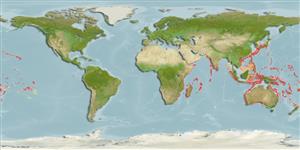Environment: milieu / climate zone / depth range / distribution range
Ecologie
marien bathydemersaal; diepte 150 - 300 m (Ref. 5222). Deep-water; 44°N - 39°S, 29°E - 136°W (Ref. 5222)
Indo-West Pacific: Somalia and South Africa to Japan, Australia and New Zealand. Except for Japan, China, and Korea, most distribution records for Epinephelus septemfasciatus are probably based on this species. Reported as Epinephelus compressus by Postel et al. (Ref. 6453).
Grootte / Gewicht / Leeftijd
Maturity: Lm ? range ? - ? cm
Max length : 130 cm TL mannelijk / geslacht onbekend; (Ref. 4787); max. gepubliceerd gewicht: 80.0 kg (Ref. 4787); max. gerapporteerde leeftijd: 43 Jaren (Ref. 92312)
Dorsale stekels (totaal) : 11; Dorsale zachte stralen (totaal) : 14 - 15; Anale stekels: 3; Anale zachte stralen: 9. Distinguished by the following characteristics: body buff with 8 broad dark brown bars; blackish brown pelvic fins and distal half of the soft dorsal and anal fins; faint dark band from eye to the middle opercle spine; presence of blackish maxillary streak; minute melanophores covering gill rakers and gill arches; depth of body contained 2.2-2.7 times in SL; head length 2.4-2.5 times in SL; distinctly convex interorbital area, convex dorsal head profile; angular preopercle, enlarged serrae at angle; 0-3 small spines at lower edge of preopecle anterior to angle; distinctly serrate lower edge of subopercle and rear edge of interopercle; convex upper edge of operculum; posterior nostrils 2-3 times larger than anterior nostrils; maxilla reaches to below rear half of eye (Ref. 89707).
Probably occurs in rocky reefs. Its apparent rarity may be due to its preference for relatively deep water.
Levenscyclus en paargedrag
Maturities | Voortplanting | Spawnings | Egg(s) | Fecundities | Larven
Craig, M.T. and P.A. Hastings, 2007. A molecular phylogeny of the groupers of the subfamily Epinephelinae (Serranidae) with revised classification of the epinephelini. Ichthyol. Res. 54:1-17. (Ref. 83414)
Status op de Rode Lijst van het IUCN (Ref. 130435)
Gevaar voor de mens
Reports of ciguatera poisoning (Ref. 30302)
Gebruik door de mens
Visserij: van minder commercieel belang
Tools
Speciale rapporten
Download XML
Internetbronnen
Estimates based on models
Preferred temperature (Ref.
123201): 13.4 - 21.2, mean 15.7 °C (based on 136 cells).
Fylogenetische diversiteitsindex (Ref.
82804): PD
50 = 0.5001 [Uniqueness, from 0.5 = low to 2.0 = high].
Bayesian length-weight: a=0.01349 (0.00612 - 0.02972), b=3.03 (2.86 - 3.20), in cm total length, based on LWR estimates for this Genus-body shape (Ref.
93245).
Trofisch niveau (Ref.
69278): 4.0 ±0.7 se; based on size and trophs of closest relatives
Generation time: 10.0 ( na - na) years. Estimated as median ln(3)/K based on 2
growth studies.
Weerstandsvermogen (Ref.
120179): Zeer laag, minimale populatieverdubbelingstijd meer dan 14 jaar (Preliminary K or Fecundity.).
Fishing Vulnerability (Ref.
59153): High to very high vulnerability (68 of 100).
Nutrients (Ref.
124155): Calcium = 12.9 [6.0, 29.5] mg/100g; Iron = 0.31 [0.14, 0.67] mg/100g; Protein = 17.8 [16.0, 19.6] %; Omega3 = 0.353 [0.188, 0.660] g/100g; Selenium = 18.7 [8.2, 43.5] μg/100g; VitaminA = 8.75 [1.65, 45.73] μg/100g; Zinc = 0.27 [0.19, 0.41] mg/100g (wet weight);
